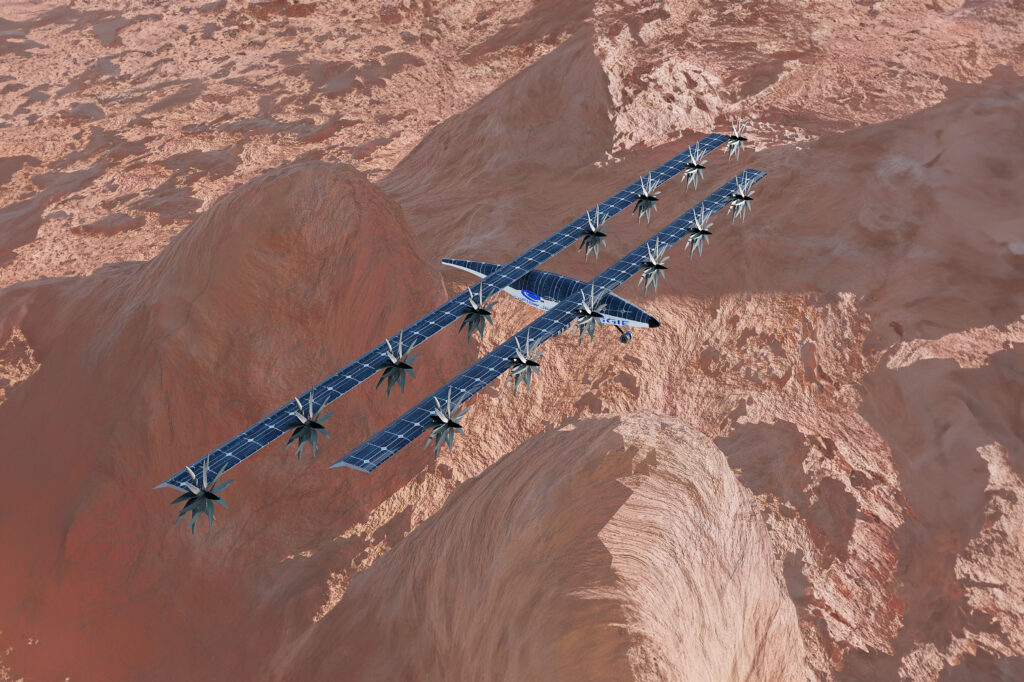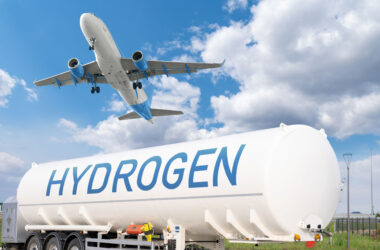Mars has been a prime target for exploration missions over the past few decades to study the planet’s atmosphere, surface, and potential for supporting life. A primary goal is to perform more widespread and comprehensive surveys of the Mars terrain, which poses challenges due to the planet’s size and limited range of ground vehicles.
This week, as part of NASA Innovative Advanced Concepts (NIAC), the US space agency progressed the innovative concept of using fixed-wing aircraft powered by solar energy to conduct atmospheric science investigations and geophysical mapping on the red planet.

The proposed Mars Aerial and Ground Intelligent Explorer (MAGGIE) could revolutionize Mars exploration as an aerial platform by enabling more efficient access to diverse surface regions.
Key Features and Capabilities of MAGGIE
MAGGIE is a compact fixed-wing aircraft designed uniquely for Mars. It can achieve vertical takeoff and landing (VTOL) through an advanced “deflected slipstream” system called CoFlow Jet (CFJ). This allows flight in the planet’s rarefied atmosphere.
With the ultra-high lift CFJ configuration, MAGGIE can cruise at Mach 0.25 – over 950 km/hr relative to Mars’s atmosphere. The lift coefficient of 3.5 is nearly 10 times that of conventional subsonic aircraft, critical for Mars’ atmospheric density, which is only 1% of Earth’s.
MAGGIE would be powered by solar energy with lithium-ion batteries providing full-range global flights. The estimated range per charge is 179 km, while the total distance travelled in one Martian year could reach an impressive 16,048 km.
Proposed MAGGIE Missions and Investigations
The MAGGIE concept study outlined three major scientific investigations aligned with NASA’s Mars exploration objectives that leverage the aircraft’s mobility.
Firstly, MAGGIE would help study Mars’ past dynamo magnetic field by surveying regions with remnants detected in large impact crater basins. This can provide insights into the evolution of Mars’ core.
Secondly, the aircraft can precisely measure atmospheric methane sources, adding high-resolution mapping to supplement previous surface and orbital detections. Understanding the origin of Martian methane is a crucial astrobiology question.
Finally, MAGGIE would map subsurface water ice deposits in mid-latitude regions to one-meter subsurface depth based on onboard high-frequency ice-penetrating radar. These surveys can identify accessible water resources for future human exploration.
Feasibility and Future Outlook
The initial MAGGIE concept study determined its viability, but additional R&D is needed, including aerodynamic verification under simulated Mars conditions.
If proven successful in further testing, MAGGIE would usher the first aircraft platform enabling global-scale exploration on Mars. The solar electric VTOL configuration provides unmatched surface access compared to the proposed Mars plane concepts.
While Mars helicopters like Ingenuity have already captured public interest, the scope of MAGGIE missions could similarly inspire as it investigates diverse, extreme regions through newly enabled aerial pathways.
What is NASA Innovative Advanced Concepts (NIAC)?
The MAGGIE concept is part of this year’s NASA Innovative Advanced Concepts (NIAC) selections. The NIAC program seeks early-stage study proposals for visionary and transformational space concepts. NIAC aims to fund high-risk, forward-looking ideas at relatively low technology readiness levels that could significantly advance future NASA and commercial missions if proven feasible.
The concepts span radical, disruptive approaches across all space science and exploration domains – from novel propulsion methods, sensing instruments, spacecraft designs, and navigation techniques to bold ideas tackling astrobiology, orbital operations, and solar system exploration challenges. Proposals undergo a two-step competitive selection process to identify the most promising ideas meriting early research.
In the list of 12 selections for the 2024 cycle, NIAC funds are awarded to individual researchers, startups, universities, NASA centres, and companies to study their futuristic concepts via 9-month feasibility analyses.
This year, ideas range from floating solar-powered aircraft for Mars and Venus, swarms of tiny probes across the solar system, new methods of imaging black holes to autonomous self-powered sensors on the Moon and beyond.
The proposed Mars Aerial and Ground Intelligent Explorer (MAGGIE) is our favourite of this year’s selection. It could significantly expand Mars terrain access and scientific capabilities through an ingenious solar-powered fixed-wing aircraft tailored for the planet’s environment.
If validated and developed, MAGGIE could provide a revolutionary platform revealing previously unseen Mars landscape and atmosph perspectives here. The promise of more diverse Red Planet mission profiles takes inspiration from aviation achievements on Earth, evolving them to push boundaries on another world.
TLDR:
- NASA proposed an innovative fixed-wing aircraft concept called MAGGIE to enable more widespread Mars exploration
- MAGGIE is uniquely designed for Mars flight with solar power, vertical takeoff and landing, and high-speed/lift
- Proposed science missions span studying Mars’ core, methane sources, and mapping subsurface ice
- Further testing is needed to verify MAGGIE’s feasibility as a revolutionary Mars exploration platform







